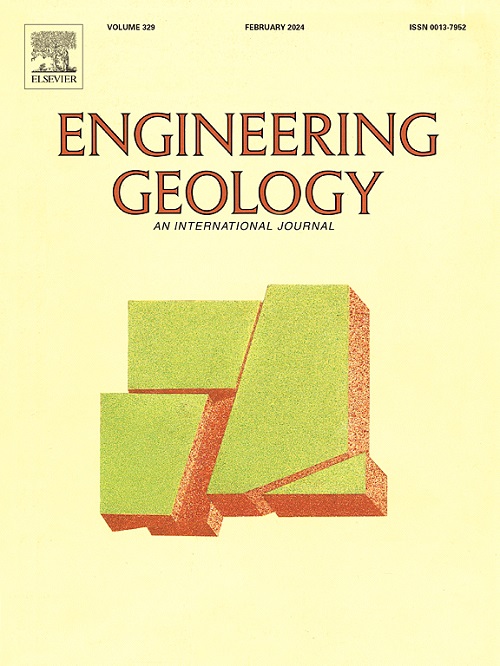Numerical investigation of the fast shear behaviour of granular materials and its significance for rapid landslides
IF 6.9
1区 工程技术
Q1 ENGINEERING, GEOLOGICAL
引用次数: 0
Abstract
The shear behaviour of granular materials at high velocities is crucial for understanding the high mobility of rapid landslides and the low-friction mechanisms behind them. Here, a numerical ring shear model driven by granular shear platens was developed, and this model was validated in terms of the kinematics and mechanics of the granular material. The granular material was then accelerated at different accelerations to high shear velocities (ranging from 0.001 m/s to a maximum of 5.0 m/s). The results indicate that with increasing shear velocity, the shear behaviour of granular materials transitions from a single behaviour to a composite behaviour. The composite shear behaviour is important for both the shear flow state and the frictional characteristics. The velocity profile reveals the transition of granular materials from uniform shear flow to composite shear flow consisting of locally high-shear-rate layers and slow creep layers; the volume of granular materials transitions from global expansion at the onset of shearing to local expansion; and particle velocity fluctuations and contact force fluctuations change from being uniformly distributed and relatively small at the beginning of shearing to rapid growth in local areas. Furthermore, with increasing shear velocity, the frictional characteristics become nonuniform. Local areas exhibit positive velocity-related friction effects, whereas the friction of the particles in other regions slightly decreases. Particle fluctuations represent an important factor that leads to the composite shear behaviour of granular materials. This study provides valuable insights into the shear behaviour of particles in rapid landslides.
颗粒材料快速剪切行为的数值研究及其对快速滑坡的意义
颗粒材料在高速下的剪切行为对于理解快速滑坡的高流动性及其背后的低摩擦机制至关重要。在此,我们建立了一个由颗粒剪切压板驱动的环形剪切数值模型,并从颗粒材料的运动学和力学角度对该模型进行了验证。然后以不同的加速度将颗粒材料加速到高剪切速度(从 0.001 m/s 到最高 5.0 m/s)。结果表明,随着剪切速度的增加,颗粒材料的剪切行为会从单一行为过渡到复合行为。复合剪切行为对剪切流动状态和摩擦特性都很重要。速度剖面显示了颗粒材料从均匀剪切流过渡到由局部高剪切速率层和慢蠕变层组成的复合剪切流;颗粒材料的体积从剪切开始时的整体膨胀过渡到局部膨胀;颗粒速度波动和接触力波动从剪切开始时的均匀分布和相对较小转变为局部区域的快速增长。此外,随着剪切速度的增加,摩擦特性也变得不均匀。局部区域表现出与速度相关的正摩擦效应,而其他区域的颗粒摩擦力则略有下降。颗粒波动是导致颗粒材料复合剪切行为的一个重要因素。这项研究为快速滑坡中颗粒的剪切行为提供了宝贵的见解。
本文章由计算机程序翻译,如有差异,请以英文原文为准。
求助全文
约1分钟内获得全文
求助全文
来源期刊

Engineering Geology
地学-地球科学综合
CiteScore
13.70
自引率
12.20%
发文量
327
审稿时长
5.6 months
期刊介绍:
Engineering Geology, an international interdisciplinary journal, serves as a bridge between earth sciences and engineering, focusing on geological and geotechnical engineering. It welcomes studies with relevance to engineering, environmental concerns, and safety, catering to engineering geologists with backgrounds in geology or civil/mining engineering. Topics include applied geomorphology, structural geology, geophysics, geochemistry, environmental geology, hydrogeology, land use planning, natural hazards, remote sensing, soil and rock mechanics, and applied geotechnical engineering. The journal provides a platform for research at the intersection of geology and engineering disciplines.
 求助内容:
求助内容: 应助结果提醒方式:
应助结果提醒方式:


